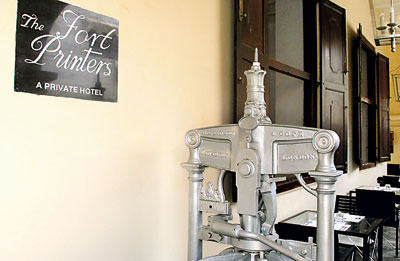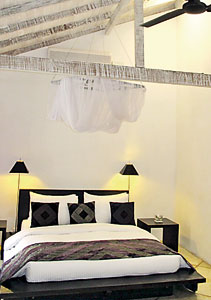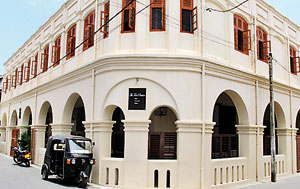A school, a printers: If only these walls could speak
View(s):In his search for unusual hotels to review for a new edition of his Bradt Guide to Sri Lanka, Royston Ellis visits The Fort Printers
It’s called The Fort Printers and this boutique hotel in the centre of Galle Fort has an intriguing history. It was a former printers before it was transformed into a hotel, but before that it was a pioneering school.

Remnants of a bygone era: A press, painted silver stands on the verandah and the prefect’s room

Since it opened for guests in 2004, The Fort Printers has proved so popular that its owner is opening an extension of three rooms in a converted mansion opposite the hotel, and a further five rooms in the renovated Dutch era building adjoining the Printers.
The solid frontage embracing the corner of Galla Fort’s Pedlar & Church Streets, conceals an extraordinary link with Sri Lanka’s history. The building, originally an 18th century mansion, was adapted to house the original Mahinda College, which opened there on March 1 1892 at the instigation of The Buddhist Philosophical Society founded by Colonel Olcott. It was named after Arhant Mahinda Thera, the Buddhist monk who brought Buddhism to Sri Lanka.
The primary classes were held downstairs and the higher classes and the principal’s quarters were upstairs. That pattern has been followed in the modern renovation, with the Prefect’s Suite being downstairs and the Headmaster’s Suite, and former classrooms, now bedrooms, known as Geography, History and Art, upstairs.
In 1903, an Englishman called F. L. Woodward arrived as Headmaster. He described the school environment as “a den of wickedness with an Arrack tavern nearby and a house of ill-fame next door.”
When the first motorcar arrived in Galle in 1905, the school had a roll call of 246 boys. Eventually, in 1912, the school was shifted out of its dusty, cramped conditions in Fort to become Galle’s famous Mahinda College, still renowned today. While the legend of the school is recalled in the names of the bedrooms at the hotel, there are only a few relics of the days when it was a busy printers serving the needs of the Fort’s residents. The presses and other machinery had to go to make way for the hotel conversion although a press, painted silver, stands in the verandah by the hotel’s entrance, as evidence of its past.
The spaciousness of the ground floor area has been brilliantly converted by architect Channa Daswatte into living spaces that flow from one to the other. The verandah, with tables for street-side dining, opens into a parlour with shiny tiled floor and vast settees opposite a neatly set up restaurant. There is another room with a single refectory table laid out for more formal dining in front of the entrance to the inner courtyard.
Tables for dining are set up in the courtyard too, since the hotel is open for non-residents to enjoy refined versions of wholesome local cuisine. Reproduction antique stand fans keep the temperature cool, while the service is equally gentle. Surprisingly there is a lap pool with frangipani petals floating in it in the courtyard shielded by a high sandstone wall.
The Prefect’s Suite with its simple, but comfortable furnishings and gorgeous retro bathtub for contemplative wallowing, is the only ground floor bedroom. There is no ceiling and a fan churns from the roof, although there is air-conditioning too. It is a tranquil contrast to the cacophony of kids and printing presses of the past.

The imposing colonial building
A doorway through the sandstone wall gives access to the newest wing, five rooms converted out of a building with stout columns and deep verandah with low overhanging roof, typical of practical, colonial architecture designed to be cool, before the advent of air-conditioning. There is a dining and entrance lobby there too, and an auxiliary kitchen but the main focus of the hotel remains the original Printers building.
A new extension lies at the other side of Pedlar Street with three self-contained rooms and an auxiliary kitchen where guests can fend for themselves if they want. That should suit the independent minded visitors who want a private retreat in the Fort.
The atmosphere of Galle Fort changes as the sun sets. The eager tourists in fashionable shorts and shawls, busily photographing everything in sight while fending off opportunists, fade away as dusk falls. Galle Fort seems to return to the spirit of the past with those who have lived there for years chatting on their stoeps, enjoying the night air.
Memories of the first Mahinda College, of the days when the printing presses clanged and of the long-closed boisterous arrack tavern, mingle with the sighs of contentment as guests confidently relax in this unusual hotel that is part of Galle Fort’s intriguing heritage.
The Fort Printers, 39 Pedlar Street, Galle Fort; tel: 091 2247977; email: theprinters@sltnet.lk; www.thefortprinters.com
Follow @timesonlinelk
comments powered by Disqus




















